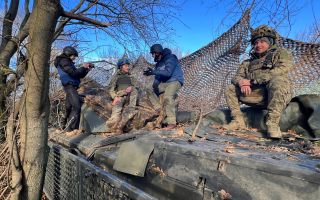When hell broke loose: Eighty years since the controversial bombing of Dresden
It has been 80 years since one of the most controversial bombing missions of the Second World War that saw British and American bombers virtually level the undefended German city of Dresden, killing an estimated 25,000 people.
Remembered by many Germans as Die Mordnacht von Dresden – The Murder Night in Dresden – the attack was controversial for its timing, as it happened so close to the end of the war, and brutality.
The controversy also stems from the fact Dresden wasn't considered important to wartime production or a major industrial centre.
In comparison with other German cities, Dresden's contribution to the war effort was considered minimal.
However, the National Archives hold 'Dresden Target Files' that show targets as being railway stations, marshalling yards, bridges, armament factories – one being an alleged poison gas factory – airfield and radar facilities.
In his memoirs, Prime Minister Winston Churchill describes Dresden as "a centre of communications for Germany's Eastern Front".
Additionally, Churchill refers to a telegram that General Eisenhower sent to Joseph Stalin on 28 March 1945.
In it, Eisenhower stated that after isolating the Ruhr, he planned to make his main advance along the Erfurt-Leipzig-Dresden axis.
This strategy aimed to connect with the Russians and effectively divide the remaining German forces.

However, those who survived the bombing attack saw it as a barbaric, indiscriminate act that carelessly killed 25,000 innocent civilians so close to the end of the war.
The terror bombing, as it was known, created a firestorm so large it sucked oxygen from the air, suffocating people desperately trying to escape the flames.
Describing the horrors faced by the civilian population, one Dresden resident wrote: "After the first attack this great city was burning in an area 7km long and 4km wide.
"The second attack began two-and-one-half hours later.
"Thirty-five minutes long the earth trembled under the impact of numberless bombs and 10 hours later the third attack followed in daylight in undiminished intensity on the last suburbs of Dresden not yet burned."
Operation Thunderclap – what happened?
Between 13 and 15 February 1945, more than 1,200 Allied bombers of the Royal Air Force and the US's Eighth Air Force launched four aerial attacks against Dresden.
In the book Der Tod Von Dresden – The Death of Dresden – by Axel Rodenberger, the author writes: "The clock of the Church of Our Lady showed 10.09 o'clock.
"Hell broke loose. The earth trembled.
"Bombs exploded, drowning the noise of the motors."
Operation Thunderclap, a large-scale aerial attack designed to force a surrender, had begun and was about to obliterate 13 sq miles of the city once nicknamed Florence on the Elbe for its beauty and was well known for its historical and cultural significance.
It was also filled with German refugees fleeing the Soviet advance and desperately seeking shelter.
A United States Air Forces in Europe report on the Dresden bombing describes the city as welcoming thousands of displaced civilians before the bombings.
It said: "Unending streams of refugees poured into Dresden by day and by night, jamming all the railroad stations, blocking the streets with vehicles, filling each house to the last place, and camping by the thousands in the cold, wet weather in the city squares, parks, and the meadows by the Elbe River.
"On the night of its destruction, Dresden sheltered 700,000 refugees according to German estimates, in addition to its normal population of over 600,000 residents."
Bomber Command's campaign diary from February 1945 notes that, in two separate raids, 796 Lancasters and nine Mosquitos dropped 1,478 tonnes of high explosive and 1,182 tonnes of incendiary bombs.

No 5 Group carried out the first attack, used low-level marking methods and was considered "only moderately successful".
Three hours later an all-Lancaster attack by aircraft of Nos 1, 3, 6 and 8 Groups, with No 8 Group providing standard Pathfinder marking, saw 529 Lancasters drop more than 1,800 tonnes of bombs with "great accuracy".
The diary says: "Much has been written about the fearful effects of this raid.
"Suffice it to say here that a firestorm, similar to the one experienced in Hamburg in July 1943, was created and large areas of the city were burnt out."
On 14 February, 311 American B-17s dropped 771 tonnes of bombs on Dresden in an attempt to attack the railway yards.
The campaign diary then says: "The Americans bombed Dresden again on the 15th and on 2 March, but it is generally accepted that it was the RAF night raid which caused the most serious damage."

In Volume III, The Fight Is Won, of Royal Air Force, an officially commissioned history by Denis Richards and Hilary St G Saunders, the authors write of what it was like for civilians on the ground during the bombing campaign, saying: "Mrs Riedl crawled through the last hole, dipped the blanket which she carried in a tub half full of dirty water which was standing nearby and flung it, dripping wet, over her head and round her shoulders.
"These precautions saved her life, and together with about 20 others, who had likewise left the burning cellars, she crouched in the middle of the road where they all remained for seven hours until at long last rain fell and momentarily damped the fires with which they were surrounded.
"About eight in the morning Mrs Riedl and her companions began to grope their way out of the town towards the river into which many persons had thrown themselves.
"Its banks and the open spaces beside them were choked with the bodies of those caught in the open by the second attack."
Today, the buildings destroyed in the bombings have either been reconstructed based on their original designs or replaced with modern architecture.
Some of the ruins were left intact as a way to honour and remember the dead and to ensure future generations are aware of the price of conflict.
One notable feature of this reconstruction is the Frauenkirche, or Church of Our Lady, which serves as a symbol of reconciliation.
The cross at the top of its tower was gifted by Dresden's twin city of Coventry and crafted by a metalsmith whose father was part of the British bomber crews that targeted Dresden during the war.
The bombing of Dresden in February 1945 remains one of the most controversial campaigns of the Second World War, profoundly impacting countless lives forever.









